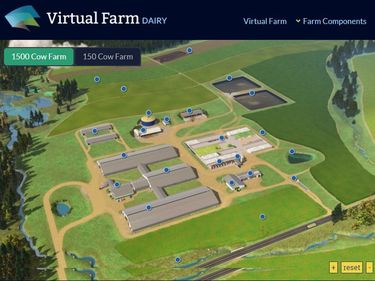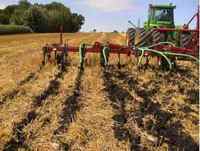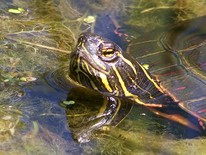 Virtual Farm lets you explore the typical components of both small and large dairy farms.
The USDA Sustainable Dairy Virtual Farms shows typical dairy farming practices for modern farming systems with 150 and 1500 cows. Each system can be investigated at a variety of levels by using the mouse to hover over a farm component. By drilling down deeper and deeper into the knowledge base, the user will gain a better understanding of how farm operations work.
About: The USDA Sustainable Dairy initiative examines dairy production systems across the Great Lakes region of the United States and how environmental impacts can be reduced without sacrificing productivity or profit. Explore the systems and components that make up modern dairy farms and learn how management practices impact sustainable production while addressing climate change challenges.
A webinar will be held on
Wednesday, December 13, 2017 from 10:30 - 11:30 am to provide an opportunity
to learn more about the process DNR used to develop the 2018 impaired waters
list and to ask any questions about that process and specific findings.
Connect
to the Webinar by clicking
here.
You can also connect by phone: 1 (866)
715-6499
If you call in by phone use this Conference ID: 6833129086
This webinar will contain visuals
so if you do connect by phone you will miss some material.
A recording of the webinar and
materials shown will be posted on the DNR website in the days following the
webinar (2018
Impaired Waters List Webpage).
Public comments on the
draft 2018 impaired waters list may be submitted by December 29, 2017 and can
be emailed to DNR at DNRImpairedWaters@wisconsin.gov,
or sent by U.S. mail to Ashley Beranek, DNR, Water Evaluation Section (WY/3),
Box 7921, Madison, WI 53707

SNAP Plus Training
Numerous options for SNAP Plus training are available, with a Madison class added on Dec 20th.
- Dec 7th: Mauston, Western Tech College, 1000 College Ave
- Dec 8th: Luxemburg, Exhibition Building, 625 Third St.
- Dec 14th: Wausau, Room 2 at 212 River Drive
- Dec 15th: Jefferson, County Government Office, 864 Collins
Road
- Dec 19th: Eau Claire, Chippewa Valley Tech College, 4000
Campus Road
- Dec 20th:
Madison, DATCP, 8911 Agriculture Dr., Room 266
The course will cover the new checklist, SnapPlus 17 (not
publically released yet), including SnapMaps and the new 590 changes, and have time at the end for specific problems or questions.
All of the trainings will be from 10am – 2pm. Lunch will be
on your own. Registration is required, please email Stephanie.schneider@wi.gov
to save your spot.
The University of Wisconsin-Extension in conjunction with UW-Madison Department of Soil Science will conduct eight Soil, Water and Nutrient Management Meetings Nov. 29 – Dec. 5, 2017 around the state to provide research updates in the field of soil management, fertility, and nutrient management.
Presentations include:
- Building soil organic matter
- Principles of nitrogen use efficiency
- Cover crop research update
- The value of crop residues
- Cover crop survey results
- Wisconsin nutrient management update
- Machinery movement for efficient forage harvest and maintaining soil health
Meetings will be either mornings from 8:30-11 a.m., with breakfast at 8 a.m. OR afternoons from 1:30-4 p.m. with lunch at 1 p.m. Registration fees are $35, which includes meals and materials. Certified Crop Adviser CEU credits (1.0 NM and 2.0 SW) have been requested. For more information
The transfer, processing, and storage of manure continues to
impact dairy operations of all sizes. In order to determine the needs of the
dairy industry with regard to this issue, we are asking for input from farmers,
industry representatives, and agency staff through a brief survey. Please
complete the survey at Manure Processing Technologies.
UW-Extension will use
the results from the survey to plan and deliver upcoming educational events on
this topic. We look forward to your input.
|

Every two years, Section 303(d) of the Clean Water Act requires states to publish a list of all waters that are not meeting water quality standards. In the proposed 2018 list update, DNR proposes to add 240 new water segments. A majority of the listing additions were waters that exceed total phosphorus criteria. Thirty-five waterbodies are proposed to be delisted.
Public Comment Materials
The Impaired Waters Search Tool may be used to search DNR’s WATERS database for previous and current impaired waters listings, as well as listing update proposals. A help guide for using the search tool [PDF] is available.
The Surface Water Data Viewer can be used to search for impaired waters listings and proposed listings in an interactive mapping application. To view impaired waters on the map, click the “Show Layers” button to expand the “Impairments and Assessments” grouping and check the “Impaired Waters Status” layer. The definitions of the listing status categories are provided here.
Contact informationFor information contact:Impaired Waters Program
|

MADISON, Wis. - The majority of Wisconsin's lakes and rivers recently assessed by the Department of Natural Resources received a good bill of health, continuing a trend of improved surface water quality across the state.
At the same time the DNR is working to identify new waterways to target for pollution reduction plans. The department's recent assessment also included 240 new waters that meet the criteria for being classified as impaired, and is seeking public comment on the new listings.
"Long-term trend and satellite monitoring show that we are making progress with good overall water quality," said Sharon Gayan, director of the DNR Water Quality Bureau. "Wisconsin waters stay healthy through combined efforts including strong partnerships with citizens, lake associations, local government, permit holders and others implementing practices that protect and restore waters of the state. However, through expanded monitoring, we've identified lakes and rivers where more work is needed to improve water quality for fish to thrive and for people to enjoy them recreationally."
|

Proposed Guidance: Urban Nonpoint Source and Storm Water (UNPS&SW) Program Construction Grant Application Instructions
Draft
guidance concerning Urban
Nonpoint Source and Storm Water (UNPS&SW) Program Construction Grant
Applications is now available for review and comment on the Proposed DNR Program
Guidance webpage.
"Urban
Nonpoint Source and Storm Water (UNPS&SW) Program Construction Grant
Application Instructions” is open for comment until December 5, 2017.
The
proposed “Urban Nonpoint Source and Storm Water (UNPS&SW) Program
Construction Grant Application Instructions” has been revised to reflect the
updated water quality need categories described in the next paragraph. The
revisions are intended to assist eligible units of government complete form
8700-299 with the updated categories. Specifically, the revised document is
proposed to replace the existing UNPS&SW Construction Grant Application
Instructions, and includes revisions to following sections:
-
Project Information: Questions A
and B
-
Part II Competitive Elements:
Question 3. Water Quality Need and Public Drinking Water Supply Bonus and the addition of:
-
Attachment K: Water Quality Need
Categories
The Department is
soliciting comments from the public on this draft guidance. Once the 21-day
notice period is complete, all comments will be considered by the Department.
After considering all public comments, revisions may be made to the guidance
document and final guidance will be made available to internal and external
stakeholders. Comments related to this draft guidance document should be sent
to: DNRNPSPROGRAM@wisconsin.gov.
|

2018 Wisconsin Wastewater Operator's Conference
The 2018 Conference Exhibitor Registration is NOW OPEN!..Join WWOA at the Grand Geneva Resort in Lake Geneva, WI from October 16 - October 19, 2018. For more;
- information and registration form, click here
- Specific questions, contact Karen at 608.355.3081.
The Wisconsin Rural Water Association offers numerous training opportunities for wastewater treatment plant operators throughout the state. Many of these classes can be counted towards satisfying the continuing education requirements of state licensure.
|
|